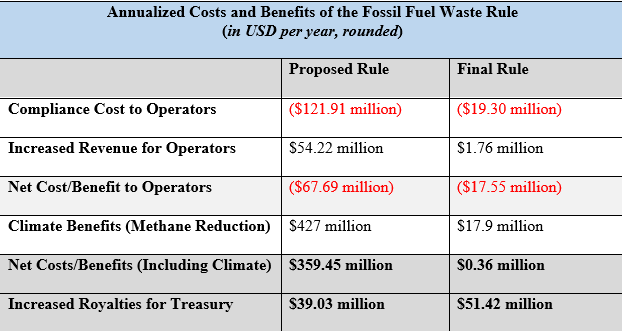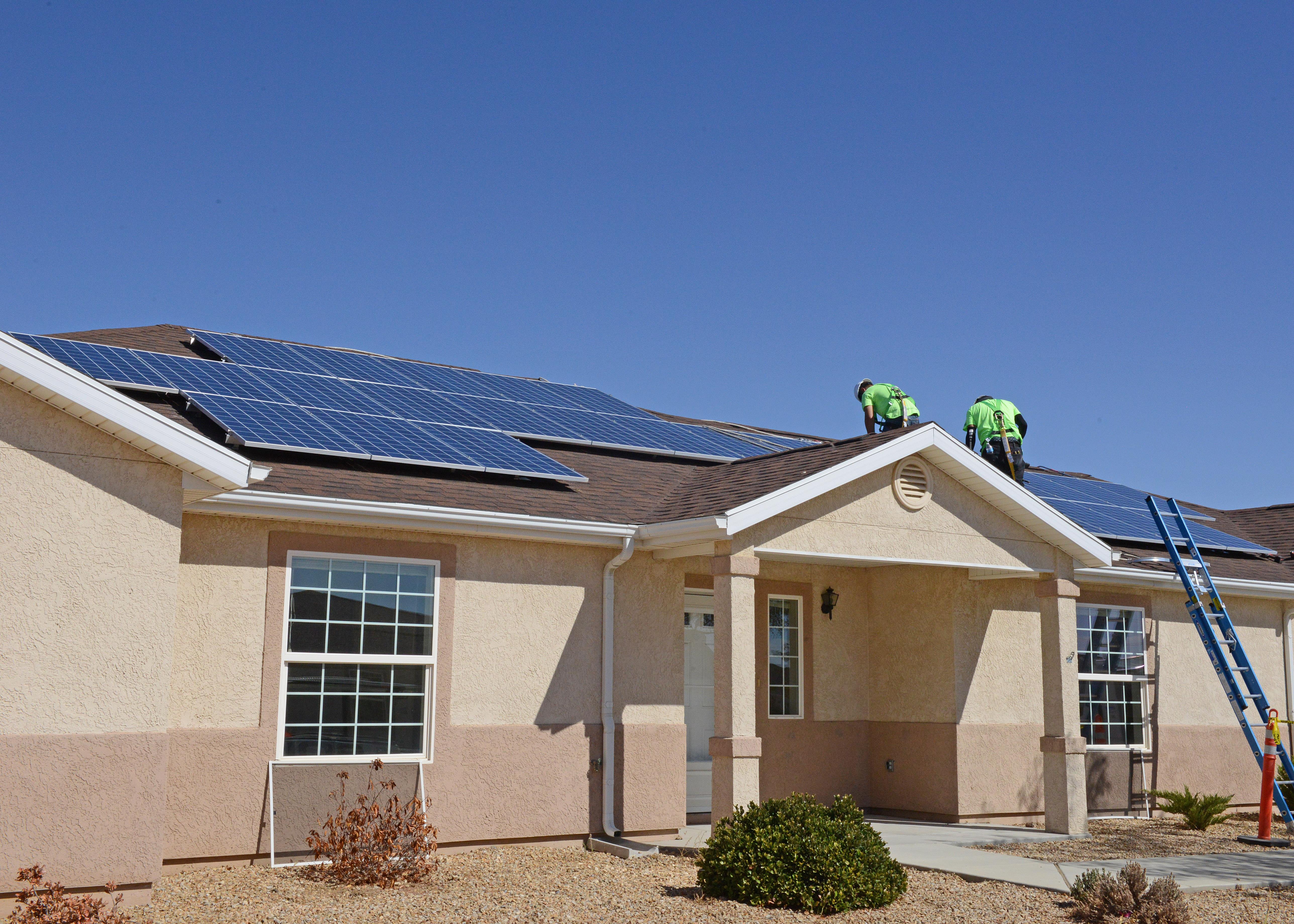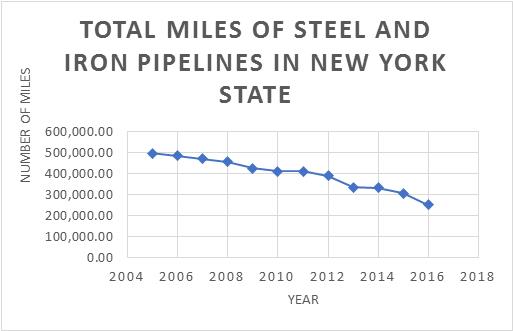
In November of 2022, when the Department of the Interior’s Bureau of Land Management (“BLM”) proposed new rules to control venting, flaring, and leaks from oil and gas leases on federal land (the “Fossil Fuel Waste Rule”), they noted that these leasing rules would have an enormous ancillary climate benefit. While the proposed rule had been designed to protect taxpayer royalties from public lands mineral leases, BLM expected that, in complying with the rule, oil and gas companies would eliminate $427 million per year of climate-related harms.
However, when BLM published its final rule on April 10, 2024, revisions to the proposed rule had eliminated nearly all of its ancillary climate benefits. In its final form, BLM estimates that the Fossil Fuel Waste Rule will prevent just $17.9 million of climate damage a year—less than 5% of its initial estimate.
This blog post provides a brief history of BLM’s Fossil Fuel Waste Rule, and explains why and how the ancillary climate benefits vanished from the final regulation. In doing so, it highlights the skeptical approach some courts have taken to climate action by non-environmental agencies, and the tension between this skepticism and President Biden’s all-of-government approach to addressing the climate crisis.
1.The Problem of Methane Leaks from Federally Managed Lands
BLM administers an oil and gas leasing program on public lands under a variety of statutes, including the Mineral Leasing Act (“MLA”), the Federal Land Policy and Management Act, and the Indian Mineral Development Act. These statutes take different forms, but generally allow BLM to lease Federal lands for oil and gas development, and require BLM to act as trustee for the benefit of Native American mineral rights. The federal leasing program is enormous; in fiscal year 2022, BLM estimates that “approximately 11 percent of all oil and 9 percent of all natural gas produced in the United States” was produced on BLM-managed land.
As part of this leasing program, BLM collects royalties based on the volume and value of oil and gas produced on federal land. However, since its inception this royalty program has contained a loophole: BLM does not seek royalties for the full volume of oil and gas extracted during production. Gas that is lost through flaring, venting, or accidental leaks is not subject to royalties, meaning that the public, who ultimately own the mineral resources in question, aren’t paid for their value.

In addition to wasting public resources, inefficient flaring, venting, and leaks from BLM-managed leases releases enormous amounts of carbon dioxide and un-combusted methane into the atmosphere. These releases have a significant impact on climate change because methane is a highly potent greenhouse gas (GHG), with a global warming impact between 27 and 30 times more potent per pound than carbon dioxide. For years, coalitions of environmental activists have pushed the federal government to reduce leaks and flaring from private oil and gas leases on federal land, and to halt the enormous and wasteful air pollution that accompanies it.
Despite these efforts, since 2010, reported flaring and venting from federal leases have massively increased. The Biden Administration’s U.S. Methane Emissions Reduction Plan, a 2021 report published by the White House Office of Domestic Climate Policy, documents that “in 2019, approximately 150 billion cubic feet of methane were flared from operations that would be subject to the BLM regulation—more than the entire yearly natural gas consumption of residential consumers in the state of Wisconsin.”
2. The Tangled History of BLM’s Fossil Fuel Waste Rule
The Fossil Fuel Waste Rule has a complex statutory and judicial background. For more than 40 years, BLM has controlled waste from public land leases under a regulatory document: “Notice to Lessees and Operators of Onshore Federal and Indian Oil and Gas Leases: Royalty or Compensation for Oil and Gas Lost” (“NTL-4A”).
On November 18, 2016, under the Obama Administration, BLM issued the “Waste Prevention Rule,” which replaced NTL-4A. The Waste Prevention Rule was designed to significantly reduce flaring, venting, and leaks, established clear guidelines for when lessees needed to pay royalties on wasted oil and gas, and set forth extensive guidance to “describe[] the reasonable steps that operators of Federal and Indian oil and gas leases must take to avoid the waste of natural gas.” At the time, BLM estimated that the rule would “reduce methane emissions by 175,000–180,000 [tons per year],” and estimated that the climate impact of this reduction would “be worth $189–$247 million per year.”
However, administration of the Waste Prevention Rule was suspended under the Trump Administration[1] and ultimately struck down in Wyoming v. DOI, 493 F. Supp. 3d 1046 (D. Wyo. 2020), with a federal District Court in Wyoming finding that the rule was inappropriately supported by “climate change benefits” and exceeded BLM’s statutory authority. The Wyoming court found that, while Congress “unambiguously grant[ed] BLM authority to regulate oil and gas production activities for the prevention of waste,” BLM had no authority to “styl[e] rules regulating air pollution as waste prevention measures,” and the rulemaking “record as a whole evince[d] a principle purpose and intent to curb air emissions from existing oil and gas sources.”
While Wyoming v. DOI was being litigated, the Trump Administration issued a significant revision to the rule on September 28, 2018.[2] As the Sabin Center documented at the time, this revision removed many of the Waste Prevention Rule’s requirements and largely reverted back to the standard set by NTL-4A, threatening a dramatic increase in methane emissions from public lands. The Trump Administration’s rule, in turn, was vacated in California v. Bernhardt, 472 F. Supp. 3d 573 (N.D. Cal. 2020), after a Federal court in California held, among other things, that the Trump Administration’s 2018 revisions were insufficiently supported by the administrative record.
3. The Biden Administration Proposes a New Methane Rule
When President Biden entered office, BLM again began attempts to update its waste rules. This effort was supported by new statutory direction. Section 50263 of the 2022 Inflation Reduction Act (“IRA”) provided that royalties are owed on all gas produced from Federal land, including gas that is consumed or lost by venting, flaring, or negligent releases through any equipment during upstream operations.
On November 30, 2022, in response to section 50263 of the IRA, BLM issued a notice of proposed rulemaking that again attempted to update BLM’s waste rules. The proposed rule took a narrower approach than the Obama-era regulations. In charting this narrow regulatory path, BLM repeatedly cited Wyoming v. DOI decision, and emphasized the rule’s compliance with that decision. BLM argued that its proposal reflected reasonable measures to avoid waste that could be expected of a prudent operator, irrespective of any impacts with respect to climate change. In particular, while BLM anticipated $427 million in annual climate benefits from the rule, it “expressly exclud[ed] the social cost of greenhouse gases from the considerations underpinning any of the proposed waste prevention requirements,” and separately assessed the waste prevention potential of the proposed rule.
In its regulatory impact assessment, BLM predicted that it would cost oil and gas lessees nearly $122 million per year to comply with the proposed rule. However, BLM expected that the proposed waste prevention rules would increase annual industry revenues by $55 million, increase annual public royalties by $39 million, and eliminate $427 million per year of climate-related harms by reducing methane leaks and discharges.
4. The Reduced Climate Impact, and Cost, of the Final Fossil Fuel Waste Rule
When BLM published the final text of the Fossil Fuel Waste Rule on April 10, 2024, the climate benefits had nearly disappeared. BLM projected that the final Fossil Fuel Waste Rule would prevent only $17.9 million worth of annual climate harm – less than 5% of the originally reported $427 million annual impact.
By analyzing the cost/benefit analyses provided by BLM, we can see how the climate benefits of the rule were lost. Between the initial proposal and the final rule, the Fossil Fuel Waste Rule was significantly modified. The reduced environmental benefit is driven by BLM’s removal of a handful of requirements in the proposed rule that would have had relatively small impacts on royalties but yielded significant emissions reductions. In particular, BLM dropped proposed requirements that would have placed tighter controls on natural-gas-activated pneumatic equipment and would have required operators to install vapor recovery equipment on certain storage tanks. In the final Fossil Fuel Waste Rule, BLM notes that its statutory focus “is on waste prevention, including loss of royalties,” and while these proposals would have a significant environmental impact they “would contribute little to assuring proper royalty collection.”

The final Methane Waste Rule, in part, attributes BLM’s decision to revise the rule to Wyoming v. DOI. In assessing public comments on the proposed rule, BLM “expressly exclude[ed] the social cost of greenhouse gases from its decisions on any of the proposed waste prevention requirements, thereby addressing the Wyoming court’s concern that the 2016 Rule was inappropriately supported by “climate change benefits.”
Given these limitations, the revisions strengthen the final rule against legal challenges. Although the final Fossil Fuel Waste Rule sacrifices many of its ancillary climate benefits, it increases royalties flowing to the Treasury, while significantly decreasing net compliance costs for oil and gas companies. BLM’s regulatory impact analysis for the final rule makes this unfortunate, but arguably necessary, tradeoff clear:
“[W]hen considering the rule without the methane reduction benefits and focusing only on gas conserved as benefits, the net benefits from the proposed rule to the final rule went from -$67 million per year (7% discount) to -$17.7 million per year . . . When considering the savings from reduced methane emissions (which is not the basis of this rule), the net benefits of $359 million/year in the proposed rule drop to $0.36 million per year in the final rule.”
Conclusion
When the Fossil Fuel Waste Rule was proposed in 2022, it set an aggressive waste standard that would, as an ancillary benefit, have significantly reduced methane emissions in the United States. Its final form is smaller, less ambitious, and less impactful. From the narrow perspective mandated by the Wyoming v. DOI, the changes to the Fossil Fuel Waste Rule were a success. Compliance costs for operators decreased by more than 75%, while royalties for the Federal government increased by almost 25%. But the overall benefit to Americans, and the world, dropped significantly.
The narrow reading of BLM’s regulatory authority adopted by the Wyoming v. DOI court, and honored by BLM in the Fossil Fuel Waste Rule, is not the only possible reading. MLA directs the Secretary of the Department of the Interior to place broad conditions on mineral leases “for the safeguarding of the public welfare” (30 U.S.C. § 187), and several scholars, within the Sabin Center and outside of it, have argued that MLA gives BLM a duty to consider the climate impact of its leasing activity. A less cautious regulator might have viewed the Fossil Fuel Waste Rule as an opportunity to push the bounds of the Wyoming court’s reading to take much-needed climate action.
BLM’s action on the Fossil Fuel Waste Rule is not a defeat for climate action – far from it. The rule remains much-needed regulation that will have significant environmental benefits, even in its reduced form. In addition, EPA has recently finalized several environmentally focused regulations that will significantly limit pollution from the oil and gas industry. However, the shrinking Fossil Fuel Waste Rule demonstrates the challenges President Biden has faced in enacting his whole-government climate agenda, and the extent to which regulatory climate action can be hamstrung by litigation. As President Biden nears the end of its first term, faced with a tightly contested election, agencies like BLM may feel pressure to finalize small, safer regulations to protect the environmental agenda of the Biden Administration against a possible Trump victory. Smaller but safer climate victories, like those in the Fossil Fuel Waste Rule, may be the result.
[1] The Sabin Center’s 2017 comments on the Trump Administration’s proposed suspension of the waste Prevention Rule are available here.
[2] The Sabin Center’s 2018 comments on the Trump Administration’s rulemaking are available here.
Martin Lockman is the Climate Law Fellow at the Sabin Center for Climate Change Law






